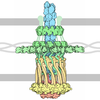[English] 日本語
 Yorodumi
Yorodumi- PDB-9k8v: Cryo-EM structure of the Type II secretion system protein from Vi... -
+ Open data
Open data
- Basic information
Basic information
| Entry | Database: PDB / ID: 9k8v | |||||||||||||||||||||
|---|---|---|---|---|---|---|---|---|---|---|---|---|---|---|---|---|---|---|---|---|---|---|
| Title | Cryo-EM structure of the Type II secretion system protein from Vibrio cholerae | |||||||||||||||||||||
 Components Components | General secretion pathway protein D | |||||||||||||||||||||
 Keywords Keywords | PROTEIN TRANSPORT / Secretion / GspD / nanopore sequencing | |||||||||||||||||||||
| Function / homology |  Function and homology information Function and homology informationprotein secretion by the type II secretion system / type II protein secretion system complex / cell outer membrane / identical protein binding Similarity search - Function | |||||||||||||||||||||
| Biological species |  | |||||||||||||||||||||
| Method | ELECTRON MICROSCOPY / single particle reconstruction / cryo EM / Resolution: 2.39 Å | |||||||||||||||||||||
 Authors Authors | Liu, R.H. / Feng, Q.S. / Zhang, K. / Dai, X. / Dai, J. / Guo, X.R. / Lin, W.F. / Wang, Z.F. / Fu, Y. / Li, Y. | |||||||||||||||||||||
| Funding support | 1items
| |||||||||||||||||||||
 Citation Citation |  Journal: To Be Published Journal: To Be PublishedTitle: Cryo-EM structure of the Type II secretion system protein from Vibrio cholerae Authors: Liu, R.H. / Feng, Q.S. / Zhang, K. / Dai, X. / Dai, J. / Guo, X.R. / Lin, W.F. / Wang, Z.F. / Fu, Y. / Li, Y. | |||||||||||||||||||||
| History |
|
- Structure visualization
Structure visualization
| Structure viewer | Molecule:  Molmil Molmil Jmol/JSmol Jmol/JSmol |
|---|
- Downloads & links
Downloads & links
- Download
Download
| PDBx/mmCIF format |  9k8v.cif.gz 9k8v.cif.gz | 1016.2 KB | Display |  PDBx/mmCIF format PDBx/mmCIF format |
|---|---|---|---|---|
| PDB format |  pdb9k8v.ent.gz pdb9k8v.ent.gz | Display |  PDB format PDB format | |
| PDBx/mmJSON format |  9k8v.json.gz 9k8v.json.gz | Tree view |  PDBx/mmJSON format PDBx/mmJSON format | |
| Others |  Other downloads Other downloads |
-Validation report
| Summary document |  9k8v_validation.pdf.gz 9k8v_validation.pdf.gz | 1.5 MB | Display |  wwPDB validaton report wwPDB validaton report |
|---|---|---|---|---|
| Full document |  9k8v_full_validation.pdf.gz 9k8v_full_validation.pdf.gz | 1.5 MB | Display | |
| Data in XML |  9k8v_validation.xml.gz 9k8v_validation.xml.gz | 142.4 KB | Display | |
| Data in CIF |  9k8v_validation.cif.gz 9k8v_validation.cif.gz | 220.2 KB | Display | |
| Arichive directory |  https://data.pdbj.org/pub/pdb/validation_reports/k8/9k8v https://data.pdbj.org/pub/pdb/validation_reports/k8/9k8v ftp://data.pdbj.org/pub/pdb/validation_reports/k8/9k8v ftp://data.pdbj.org/pub/pdb/validation_reports/k8/9k8v | HTTPS FTP |
-Related structure data
| Related structure data |  62181MC M: map data used to model this data C: citing same article ( |
|---|---|
| Similar structure data | Similarity search - Function & homology  F&H Search F&H Search |
- Links
Links
- Assembly
Assembly
| Deposited unit | 
|
|---|---|
| 1 |
|
- Components
Components
| #1: Protein | Mass: 45581.309 Da / Num. of mol.: 15 Source method: isolated from a genetically manipulated source Source: (gene. exp.)  Gene: gspD, pulD_1, BC353_04215, D6U24_10165, ERS013165_01580, FLM12_02685, QXB71_001789 Production host:  Has protein modification | N | |
|---|
-Experimental details
-Experiment
| Experiment | Method: ELECTRON MICROSCOPY |
|---|---|
| EM experiment | Aggregation state: PARTICLE / 3D reconstruction method: single particle reconstruction |
- Sample preparation
Sample preparation
| Component | Name: GspD / Type: COMPLEX / Entity ID: all / Source: RECOMBINANT |
|---|---|
| Molecular weight | Experimental value: NO |
| Source (natural) | Organism:  |
| Source (recombinant) | Organism:  |
| Buffer solution | pH: 7.5 |
| Specimen | Embedding applied: NO / Shadowing applied: NO / Staining applied: NO / Vitrification applied: YES |
| Vitrification | Cryogen name: ETHANE |
- Electron microscopy imaging
Electron microscopy imaging
| Experimental equipment |  Model: Titan Krios / Image courtesy: FEI Company |
|---|---|
| Microscopy | Model: TFS KRIOS |
| Electron gun | Electron source:  FIELD EMISSION GUN / Accelerating voltage: 300 kV / Illumination mode: FLOOD BEAM FIELD EMISSION GUN / Accelerating voltage: 300 kV / Illumination mode: FLOOD BEAM |
| Electron lens | Mode: BRIGHT FIELD / Nominal defocus max: 3000 nm / Nominal defocus min: 1200 nm |
| Image recording | Electron dose: 55 e/Å2 / Film or detector model: GATAN K3 (6k x 4k) |
- Processing
Processing
| EM software |
| ||||||||||||
|---|---|---|---|---|---|---|---|---|---|---|---|---|---|
| CTF correction | Type: NONE | ||||||||||||
| Symmetry | Point symmetry: C15 (15 fold cyclic) | ||||||||||||
| 3D reconstruction | Resolution: 2.39 Å / Resolution method: FSC 0.143 CUT-OFF / Num. of particles: 111644 / Symmetry type: POINT |
 Movie
Movie Controller
Controller


 PDBj
PDBj
